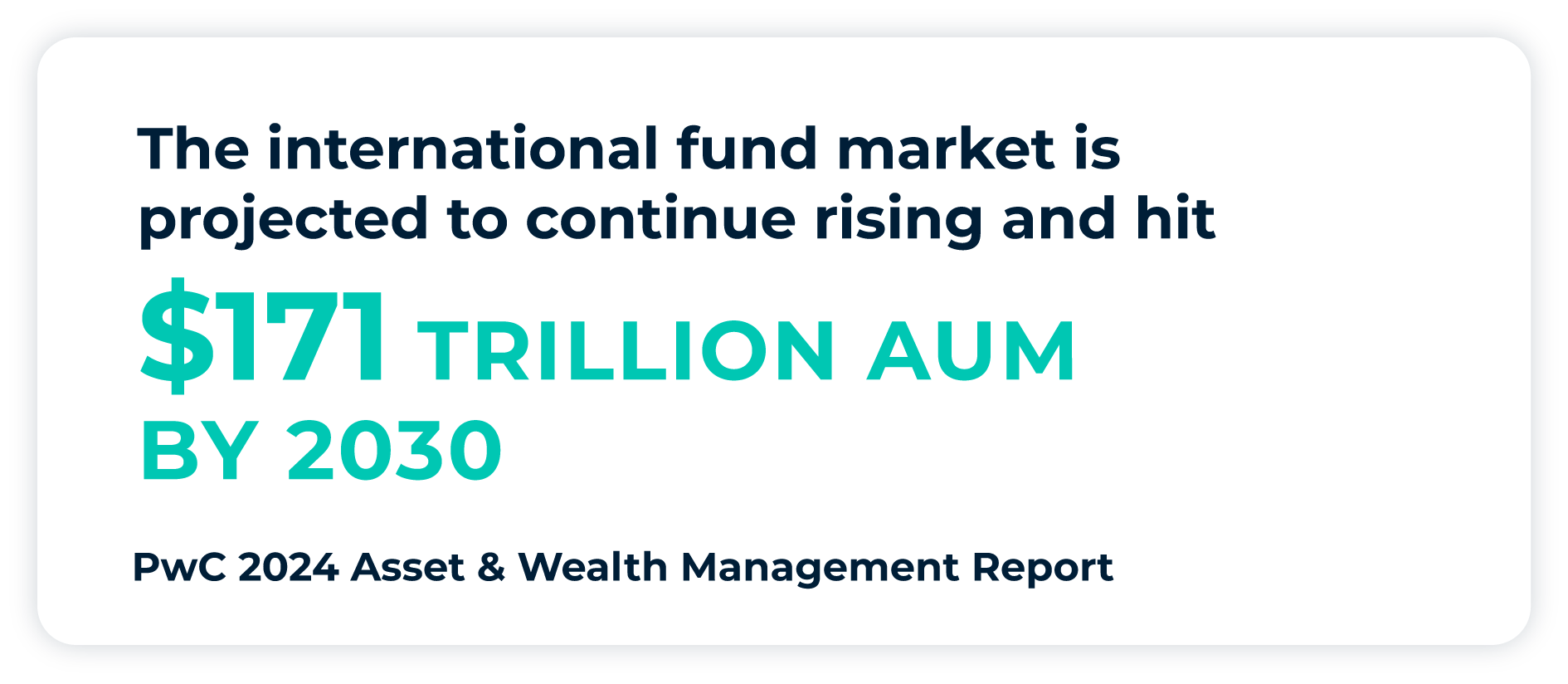Foreign exchange hedging strategies for investment funds

Global investment funds face constant pressure from foreign exchange (FX) risk, a threat just as substantial as market turbulence or compliance issues. After all, currency fluctuations can erode returns, misalign liabilities, and derail investor expectations.
Whether allocating capital across developed or emerging markets, funds inevitably take on currency exposure. While this strategy can sometimes boost returns, it often creates uncertainty that can hinder performance, complicate liability management, and make it harder to meet investor mandates.
With new growth opportunities around the world, global assets under management (AUM) reached a record $128 trillion in 2024, a 12% increase from the previous year. The international fund market is projected to continue rising and hit $171 trillion AUM by 2030.
As more funds go global, investment fund managers are increasingly turning to FX hedging strategies as essential tools for stabilizing returns and building long-term resilience.

How global funds can reduce FX risk
Liability-driven investment strategies rely on predictable cash flows to meet obligations. However, currency swings that reduce portfolio value can disrupt these objectives, leading to funding shortfalls or difficulty maintaining payout schedules.
To counter such volatility, funds can implement hedging strategies* to ensure stability in the face of unpredictability. Hedging strategies vary depending on investment horizon, liquidity needs, and mandate requirements.
The most common FX hedging tools include:
- Forward contracts: Agreements to exchange currencies at a predetermined rate on a future date. Forward contracts are widely used for their simplicity and cost-effectiveness, particularly for short- to medium-term exposures.
- Options: Contracts that give the right, but not the obligation, to exchange currencies at a set rate. FX options are valuable for funds seeking downside protection while preserving upside potential.
- Cross currency swaps: Agreements to exchange principal and interest payments in different currencies. Swaps are beneficial for long-term exposures or liability matching.
- Futures contracts: Exchange-traded alternatives to forwards that provide standardized terms and counterparty protection. Futures are best suited for highly liquid currency pairs.
The choice of instrument depends on factors such as cost, duration of exposure, and the fund’s risk appetite. Fund managers who utilize foreign exchange hedging strategies often employ a combination of these tools to balance flexibility and cost efficiency.
Best practices for FX hedging for investment funds
As tools and platforms evolve, implementing effective hedging strategies is becoming more accessible. Fund managers can partner with a forward-thinking cross-border finance expert, like Convera, to control the myriad of risks posed by currency volatility.
Some of the most effective strategies for hedging FX risk include:
Policy alignment
A clear FX risk policy is foundational. It should define objectives, such as return stabilization, liability matching, and mandate compliance. It should also specify acceptable instruments and outline governance processes. This ensures that hedging decisions are consistent and auditable.
Dynamic vs. static hedging
Some funds adopt a static hedge ratio, such as 50% or 100% of their currency exposure, while others adjust dynamically based on market conditions. A hybrid approach that maintains a baseline hedge with tactical adjustments is often effective in balancing both risk and cost.
Cost management
Hedging costs can erode returns if not monitored. Global investment funds should evaluate the trade-off between reduced volatility and hedging expenses, considering factors such as interest rate differentials and option premiums.
Technology and data utilization
Advances in data analytics, AI, and fintech solutions enable funds to monitor exposures in real time, assess hedging effectiveness, and streamline execution. Leveraging these tools enhances decision-making and transparency.
Regular review and reporting
As currency markets evolve rapidly, investment fund managers should regularly review their hedging strategies. Performance assessments help ensure that hedges remain aligned with both fund objectives and market realities.

FX hedging in an era of market volatility
Hedging is not about eliminating all risk. It’s about managing uncertainty to protect fund performance, safeguard liabilities, and deliver on investor mandates.
With heightened geopolitical risks, divergent central bank policies, and persistent inflationary pressures, FX volatility is unlikely to subside soon. For global funds, ignoring this risk is no longer a viable option.
Instead, funds should integrate proactive FX risk management into broader portfolio and liability strategies.
Global investment funds cannot afford to overlook international uncertainty related to FX risk. By adopting robust hedging strategies, funds can stabilize returns, align assets with liabilities, and build credibility with investors. While hedging does incur costs, the long-term benefits of reduced volatility, enhanced predictability, and stronger investor confidence can often outweigh the expense.
By leveraging these strategies, fund managers can claim a competitive edge, turning FX risk from a destabilizing force into a managed variable and strengthening their ability to deliver consistent, resilient performance in a complex global market.
* Convera’s hedging products are derivative financial instruments which may expose you to risk should the underlying exposure you are hedging cease to exist. They may be suitable if you have a high level of understanding and accept the risks associated with derivative financial instruments that involve foreign exchange and related markets. If you are not confident about your understanding of derivative financial instruments, or foreign exchange and related markets, we strongly suggest you seek independent advice before making the decision to use these instruments.
link





